Tajikistan profile,
Tajikistan (pronounced /təˈdʒɪkɨstæn/ or /təˈdʒiːkɨstæn/; Тоҷикистон [ˈtɔdʒikɪsˈtɔn]), officially the Republic of Tajikistan (Tajik: Ҷумҳурии Тоҷикистон, Jumhurii Tojikiston; Russian: Республика Таджикистан, Respublika Tadzhikistan; Persian: جمهوری تاجیکستان Jomhuri-ye Tajikestan), is a mountainous landlocked country in Central Asia. Afghanistan borders it to the south, Uzbekistan to the west, Kyrgyzstan to the north, and People's Republic of China to the east. Tajikistan also lies adjacent to Pakistan and the Gilgit-Baltistan region, separated by the narrow Wakhan Corridor.
Most of Tajikistan's population belongs to the Persian-speaking Tajik ethnic group, who share language, culture and history with Afghanistan and Iran. Once part of the Samanid Empire, Tajikistan became a constituent republic of the Soviet Union in the 20th century, known as the Tajik Soviet Socialist Republic (Tajik SSR). Mountains cover over 90% of this Central Asian republic.
After independence, Tajikistan suffered from a devastating civil war which lasted from 1992 to 1997. Since the end of the war, newly established political stability and foreign aid have allowed the country's economy to grow. Trade in commodities such as cotton and aluminium has contributed greatly to this steady improvement.
Etymology
Tajikistan means the "Land of the Tajiks". Some believe the name Tajik is a geographic reference to the crown (تاج Taj) of the Pamir Knot, but this is a folk etymology. The word Tajik was used to differentiate Persians from Turks in Central Asia, starting as early as the 10th century. The addition of 'k' might have been for the purpose of euphony in the set phrase Turk-o Tajik ("Turks and Tajiks") which in Persian-language histories is found as an idiomatic expression meaning "everyone."
Tajikistan frequently appeared as Tadjikistan or Tadzhikistan in English, transliterated from the Russian Таджикистан (in Russian the phoneme /d͡ʒ/ is spelled дж, that is, dzh or dj.) Tadzhikistan is the most common alternate spelling and is widely used in English literature derived from Russian sources. "Tadjikistan" is the spelling in French and can occasionally be found in English language texts.
Controversy surrounds the correct term used to identify people from Tajikistan. The word Tajik has been the traditional term used to describe people from Tajikistan and appears widely in literature. But the ethnic politics of Central Asia have made the word Tajik a controversial word, as it implies that Tajikistan is only a nation for ethnic Tajiks and not ethnic Uzbeks, Russians, etc.
Likewise, ethnic Tajiks live in other countries, such as China, Uzbekistan, Pakistan and Afghanistan, United States of America, Russia making the term ambiguous.
History of Tajikistan

Modern Tajiks regard the Samanid Empire as the first Tajik state. This monument in Dushanbe honors Amir Ismail Samani.
The territory of what is now Tajikistan has been inhabited continuously since 4000 BCE. It has been under the rule of various empires throughout history, for the longest period being part of the Persian Empire.
Acharya Yaska's Nirukta(7th century BCE) attests that the verb Śavati in the sense "to go" was used by only the Kambojas. It has been shown that the modern Ghalcha dialects, Valkhi, Shigali, Sriqoli, Jebaka (also called Sanglichi or Ishkashim), Munjani, Yidga and Yaghnobi, mainly spoken in Pamirs and countries on the headwaters of the Oxus, still use terms derived from ancient Kamboja Śavati in the sense "to go".The Yaghnobi language, spoken by the Yaghnobis in the Sughd Province around the headwaters of Zeravshan valley, also still contains a relic "Śu" from ancient Kamboja Śavati in the sense "to go".
Further, Sir George Abraham Grierson says that the speech of Badakshan was a Ghalcha until about three centuries ago when it was supplanted by a form of Persian.[Thus, the ancient Kamboja, probably included the Badakshan, Pamirs and northern territories including the Yaghnobi region in the doab of the Oxus and JaxartesOn the east it was bounded roughly by Yarkand and/or Kashgar, on the west by Bahlika (Uttaramadra), on the northwest by Sogdiana, on the north by Uttarakuru, on the southeast by Darada, and on the south by Gandhara.
Numerous Indologists locate original Kamboja in Pamirs and Badakshan and the Parama Kamboja further north, in the Trans-Pamirian territories comprising Zeravshan valley, north up parts of Sogdhiana/Fargana — in the Sakadvipa or Scythia of the classical writers.
Thus, in the pre-Buddhist times (7th–6th century BCE), the parts of modern Tajikistan including territories as far as Zeravshan valley in Sogdiana formed parts of ancient Kamboja and the Parama Kamboja kingdoms when it was ruled by the Kambojas till it became part of Persian Achaemenid Empire. After the Persian Empire was defeated by Alexander the Great, the region became the northern part of Hellenistic Greco-Bactrian Kingdom.
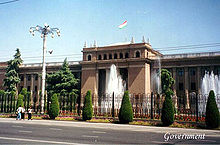
Dushanbe government building
From the last quarter of fourth century BCE until the first quarter of the second century BCE, it was part of the Bactrian Empire, from whom it was passed on to Scythian Tukharas and hence became part of Tukharistan. Contact with the Chinese Han Dynasty was made in the second century BCE, when envoys were sent to the area of Bactria to explore regions west of China.
Arabs brought Islam in the 7th century CE. The Samanid Empire supplanted the Arabs and enlarged the cities of Samarkand and Bukhara, which became the cultural centers of Tajiks (both of which are now in Uzbekistan). The Mongols would later take partial control of Central Asia, and later the land that today comprises Tajikistan became a part of the Emirate of Bukhara. A small community of Jews, displaced from the Middle East after the Babylonian captivity, migrated to the region and settled there after 600 BCE, though the majority of the recent Jewish population did not migrate to Tajikistan until the 20th century.
Russian presence
In the 19th century, the Russian Empire began to spread into Central Asia during the Great Game. Between 1864 and 1885 it gradually took control of the entire territory of Russian Turkestan from today's border with Kazakhstan in the north to the Caspian Sea in the west and the border with Afghanistan in the south. Tajikistan was eventually carved out of this territory, which historically had a large Tajik population.
After the overthrow of Imperial Russia in 1917, guerrillas throughout Central Asia, known as basmachi, waged a war against Bolshevik armies in a futile attempt to maintain independence. The Bolsheviks prevailed after a four-year war, in which mosques and villages were burned down and the population heavily suppressed. Soviet authorities started a campaign of secularization, practicing Muslims, Jews, and Christians were persecuted, and mosques, churches, and synagogues were closed.
Soviet Tajikistan

The Palace of Unity (Vahdat Palace)
In 1924, the Tajik Autonomous Soviet Socialist Republic was created as a part of Uzbekistan, but in 1929 the Tajik Soviet Socialist Republic (Tajik SSR) was made a separate constituent republic. The predominantly ethnic Tajik cities of Samarkand and Bukhara remained in the Uzbek SSR. Between 1926 and 1959 the proportion of Russians among Tajikistan's population grew from less than 1% to 13%.
In terms of living conditions, education and industry Tajikistan was behind the other Soviet Republics. In the 1980s, it had the lowest household saving rate in the USSR, the lowest percentage of households in the two top per capita income groups, and the lowest rate of university graduates per 1000 people.
By the late 1980s Tajik nationalists were calling for increased rights. Real disturbances did not occur within the republic until 1990. The following year, the Soviet Union collapsed, and Tajikistan declared its independence.
The first nation to establish an embassy in Dushanbe was Iran, which was also one of the first countries to immediately recognize Tajikistan as an independent state in 1991.
Post-independence
The nation almost immediately fell into a civil war that involved various factions fighting one another; these factions were often distinguished by clan loyalties. The non-Muslim population, particularly Russians and Jews, fled the country during this time because of persecution, increased poverty and better economic opportunities in the West or in other former Soviet republics.
Emomalii Rahmon came to power in 1994, and continues to rule to this day. Ethnic cleansing was controversial during the civil war in Tajikistan. By the end of the war Tajikistan was in a state of complete devastation. The estimated dead numbered over 100,000. Around 1.2 million people were refugees inside and outside of the country.In 1997, a ceasefire was reached between Rahmon and opposition parties (United Tajik Opposition).
Peaceful elections were held in 1999, but they were reported by the opposition as unfair, and Rahmon was re-elected by almost unanimous vote. Russian troops were stationed in southern Tajikistan, in order to guard the border with Afghanistan, until summer 2005. Since the September 11, 2001 attacks, American, Indian and French troops have also been stationed in the country.
Politics of Tajikistan
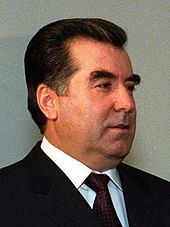
President of Tajikistan, Emomali Rahmon
Almost immediately after independence, Tajikistan was plunged into a civil war that saw various factions, allegedly backed by Russia and Iran, fighting one another. All but 25,000 of the more than 400,000 ethnic Russians, who were mostly employed in industry, fled to Russia. By 1997, the war had cooled down, and a central government began to take form, with peaceful elections in 1999.
"Longtime observers of Tajikistan often characterize the country as profoundly averse to risk and skeptical of promises of reform, a political passivity they trace to the country’s ruinous civil war," Ilan Greenberg wrote in a news article in The New York Times just before the country's November 2006 presidential election.
Tajikistan is officially a republic, and holds elections for the Presidency and Parliament. It is, however, a one party dominant system, where the People's Democratic Party of Tajikistan routinely has a vast majority in Parliament. The parliamentary elections in 2005 aroused many accusations from opposition parties and international observers that President Emomali Rahmon corruptly manipulates the election process. The most recent elections, in February 2010, saw the ruling PDPT lose 4 seats in Parliament, yet still maintain a comfortable majority. OSCE election observers said the 2010 polling "failed to meet many key OSCE commitments" and that "these elections failed on many basic democratic standards." The government insisted that only minor violations had occurred, which would not affect the will of the Tajik people.
The presidential election held on November 6, 2006 was boycotted by "mainline" opposition parties, including the 23,000-member Islamic Renaissance Party. Four remaining opponents "all but endorsed the incumbent", Rahmon.
Tajikistan has given Iran its support in Iran's membership bid to join the Shanghai Cooperation Organisation, after a meeting between the Tajik President and the Iranian foreign minister.
Administrative divisions
Tajikistan consists of 4 administrative divisions. These are the provinces (viloyat) of Sughd and Khatlon, the autonomous province of Gorno-Badakhshan (abbreviated as GBAO), and the Region of Republican Subordination (RRP – Raiony Respublikanskogo Podchineniya in transliteration from Russian or NTJ – Ноҳияҳои тобеи ҷумҳурӣ in Tajik; formerly known as Karotegin Province). Each region is divided into several districts (Tajik: Ноҳия, nohiya or raion), which in turn are subdivided into jamoats (village-level self-governing units) and then villages (qyshloqs). As of 2006, there were 58 districts and 367 jamoats in Tajikistan.
Division ISO 3166-2 Capital Area (km²) Pop (2008)
Sughd TJ-SU Khujand 25,400 2,132,100
Region of Republican Subordination TJ-RR Dushanbe 28,600 1,606,900
Khatlon TJ-KT Qurghonteppa 24,800 2,579,300
Gorno-Badakhshan TJ-BG Khorugh 64,200 218,000
Source: Population and area from State Statistical Committee of Tajikistan.
Tajikistan is landlocked, and is the smallest nation in Central Asia by area. It is covered by mountains of the Pamir range, and more than fifty percent of the country is over 3,000 meters (9,800 ft) above sea level. The only major areas of lower land are in the north (part of the Fergana Valley), and in the southern Kofarnihon and Vakhsh river valleys, which form the Amu Darya. Dushanbe is located on the southern slopes above the Kofarnihon valley.
Mountain Height Location
Ismoil Somoni Peak (highest) 7,495 m 24,590 ft North-western edge of Gorno-Badakhshan (GBAO), south of the Kyrgyz border
Ibn Sina Peak (Lenin Peak) 7,174 m 23,537 ft Northern border in the Trans-Alay Range, north-east of Ismoil Somoni Peak
Peak Korzhenevskaya 7,105 m 23,310 ft North of Ismoil Somoni Peak, on the south bank of Muksu River
Independence Peak (Revolution Peak) 6,974 m 22,881 ft Central Gorno-Badakhshan, south-east of Ismoil Somoni Peak
Akademiya Nauk Range 6,785 m 22,260 ft North-western Gorno-Badakhshan, stretches in the north-south direction
Karl Marx Peak 6,726 m 22,067 ft GBAO, near the border to Afghanistan in the northern ridge of the Karakoram Range
Mayakovskiy Peak 6,096 m 20,000 ft Extreme south-west of GBAO, near the border to Afghanistan.
Concord Peak 5,469 m 17,943 ft Southern border in the northern ridge of the Karakoram Range
Kyzylart Pass 4,280 m 14,042 ft Northern border in the Trans-Alay Range
The Amu Darya and Panj rivers mark the border with Afghanistan, and the glaciers in Tajikistan's mountains are the major source of runoff for the Aral Sea. There are over 900 rivers in Tajikistan longer than 10 kilometers.
About 2% of the country's area is covered by lakes, the best known of which are the following:
Kayrakum (Qairoqqum) Reservoir (Sughd)
Iskanderkul (Fann Mountains)
Kulikalon (Kul-i Kalon) (Fann Mountains)
Nurek Reservoir (Khatlon)
Karakul (Tajik: Qarokul; eastern Pamir)
Sarez (Pamir)
Shadau Lake (Pamir)
Zorkul (Pamir)
Lesser known lakes (all in the Pamir region) include
Bulunkul
Drumkul
Rangkul
Sasykkul
Shorkul
Turumtaikul
Tuzkul
Yashilkul
Economy of Tajikistan
Tajikistan was the poorest republic of the Soviet Union and is the poorest country in Central Asia as well as in the former Soviet Union today. With foreign revenue precariously dependent upon exports of cotton and aluminum, the economy is highly vulnerable to external shocks. In FY 2000, international assistance remained an essential source of support for rehabilitation programs that reintegrated former civil war combatants into the civilian economy, thus helping keep the peace. International assistance also was necessary to address the second year of severe drought that resulted in a continued shortfall of food production.
In 2006 GDP per capita of Tajikistan was 85% of 1990s level. While population has increased from 5.3 mln in 1991 to 7.3mln in 2009
On August 21, 2001, the Red Cross announced that a famine was striking Tajikistan, and called for international aid for Tajikistan and Uzbekistan. Tajikistan's economy grew substantially after the war. The GDP of Tajikistan expanded at an average rate of 9.6 % over the period of 2000–2007 according to the World Bank data. This improved Tajikistan's position among other Central Asian countries (namely Turkmenistan and Uzbekistan), which seem to have degraded economically ever since.Tajikistan is an active member of the Economic Cooperation Organization (ECO).
The recently completed Anzab tunnel which connects the previously hard to access Northern part of the country to the capital Dushanbe has been labeled as part of the new Silk Road. It is part of a road under construction that will connect Tajikistan to Iran and the Persian Gulf through Afghanistan.
A new bridge between Afghanistan and Tajikistan has been built which will help the country have access to trade lines with South Asia. The bridge was built by the United States.
The primary sources of income in Tajikistan are aluminium production, cotton growing and remittances from migrant workers.
Aluminium industry is represented by the state-owned Talco - the biggest aluminium plant in Central Asia and one of the biggest in the world. Tajikistan has great hydropower potential, and has focused on attracting investment for projects for internal use and electricity exports. Tajikistan is home to the hydroelectric power station Nurek with the highest dam in the world. The latest development is the Russia's RAO UES energy giant working on Sangtuda-1 hydroelectric power station (670 MW capacity) commenced operations on 18 January 2008.
Other projects at the development stage include Sangtuda-2 by Iran, Zerafshan by Chinese SinoHydro and Rogun power plant with a projected dam height of 335 metres (1,099 ft), Other energy resources include sizable coal deposits and smaller reserves of natural gas and petroleum.
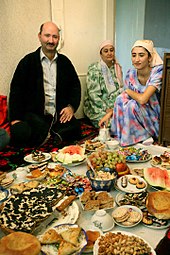
Tajik family celebrating Eid
Foreign remittance flows from Tajik migrant workers abroad, mainly in Russia, has become by far the main source of income for millions of Tajikistan's people and represents additional 36.2 % of country's GDP directly reaching the poverty-stricken population. According to some estimates about 20% of the population lives on less than US$1.25 per day. Migration from Tajikistan and the consequent remittances have been unprecedented in their magnitude and economic impact. Tajikistan has achieved transition from a planned to a market economy without substantial and protracted recourse to aid (of which it by now receives only negligible amounts), and by purely market-based means, simply by exporting its main commodity of comparative advantage — cheap labor.The World Bank Tajikistan Policy Note 2006 concludes that remittances have played an important role as one of the drivers of Tajikistan's robust economic growth during the past several years, have increased incomes, and as a result helped significantly reduce poverty.
Drug trafficking is the major illegal source of income in Tajikistan as it is an important transit country for Afghan narcotics bound for Russian and, to a lesser extent, Western European markets; some opium poppy is also raised locally for the domestic market. However with the increasing assistance from international organizations, such as UNODC, and cooperation with the US, Russian, EU and Afghan authorities a level of progress on the fight against illegal drug-trafficking is being achieved.
Tajikistan holds third place in the world for heroin and raw opium confiscations (1216.3 kg of heroin and 267.8 kg of raw opium in the first half of 2006). Drug money corrupts the country's government; according to some experts the well-known personalities that fought on both sides of the civil war and have held the positions in the government after the armistice was signed are now involved in the drug trade. UNODC is working with Tajikistan to strengthen border crossings, provide training, and set up joint interdiction teams. It also helped to establish Tajikistani Drug Control Agency.
Demographics of Tajikistan
Demographic map of Tajikistan.
Tajikistan has a population of 7,349,145 (July 2009 est.) Tajiks who speak the Tajik language (a variety of Persian) are the main ethnic group, although there is a sizable minority of Uzbeks and Russians, whose numbers are declining due to emigration. In 1989, ethnic Russians made up 7.6% of the population. The Pamiris of Badakhshan are considered to belong to the larger group of Tajiks. All citizens of Tajikistan are called Tajikistanis
The official and vernacular language of Tajikistan is Tajik. The constitution mentions Russian as the "language for interethnic communication"[ even if its use is banned in government documents.Nevertheless it is widely used in business and other fields. Despite its poverty, Tajikistan has a high rate of literacy with an estimated 99.5% of the population having the ability to read and write.The majority of the population follow Sunni Islam. There is also a sizeable minority of Ismailis and following increased nationalism after the 1992–1997 Civil War, a growing interest in and conversions to Zoroastrianism.
Bukharian Jews had lived in Tajikistan since the 2nd century BC, but today almost none are left. There is also a small population of Yaghnobi people who have lived in the mountainous district of Sughd Viloyat for many centuries. The German population in Tajikistan was 38,853 in 1979. Nearly one million Tajik men worked abroad in 2009.
Health
The state's Ministry of Labor and Social Welfare reported that 104,272 disabled people are registered in Tajikistan (2000). This group of people suffers most from poverty in Tajikistan. The government of Tajikistan and the World Bank considered activities to support this part of the population described in the World Bank's Poverty Reduction Strategy Paper. Public expenditure on health was at 1 % of the GDP in 2004.
In the early 2000s, there were 203 physicians per 100,000 people.[ Infant mortality was 59 for 1,000 live births in 2005.[48] Tajikistan is the only country in world where polio is on the increase. From zero cases in 2008 and 2009, 141 out of 237 cases worldwide has been reported in 2010.
[
Culture of Tajikistan

Tajik woman in national dress
See also: Music of Tajikistan, Public holidays in Tajikistan, and Cuisine of Tajikistan
Historically, Tajiks and Persians come from very similar stock, speaking variants of the same language and are related as part of the larger group of Iranian peoples. The Tajik language is the mother tongue of around 80% of the citizens of Tajikistan. The main urban centers in today's Tajikistan include Dushanbe (the capital), Khujand, Kulob, Panjakent and Istaravshan.
The Pamiri people of Gorno-Badakhshan Autonomous Province in the southeast, bordering Afghanistan and China, though considered part of the Tajik ethnicity, nevertheless are distinct linguistically and culturally from most Tajiks. In contrast to the mostly Sunni Muslim residents of the rest of Tajikistan, the Pamiris overwhelmingly follow the Ismaili sect of Islam, and speak a number of Eastern Iranian languages, including Shughni, Rushani, Khufi and Wakhi. Isolated in the highest parts of the Pamir Mountains, they have preserved many ancient cultural traditions and folk arts that have been largely lost elsewhere in the country.
The Yaghnobi people live in mountainous areas of northern Tajikistan. The estimated number of Yaghnobis is now about 25,000. Forced migrations in the 20th century decimated their numbers. They speak the Yaghnobi language, which is the only direct modern descendant of the ancient Sogdian language.
Tajikstan artisans created the Dushanbe Tea House, which was presented in 1988 as a gift to the sister city of Boulder, Colorado.
Education
2002-2005 public spending on education was 3.5 % of the GDP. According to a UNICEF-supported survey indicates that about 25 percent of girls in Tajikistan fail to complete compulsory primary education because of poverty and gender bias, although literacy is generally high in Tajikistan.
Religion in Tajikistan and Islam in Tajikistan
A mosque in Isfara
Sunni Islam of the Hanafi school is official religion in Tajikistan since 2009. This fact makes Tajikistan the only former Soviet state with official religion. Tajikistan considers itself a secular state with a Constitution providing for freedom of religion. The Government has declared two Islamic holidays, Id Al-Fitr and Idi Qurbon, as state holidays. According to a 2009 U.S. State Department release, the population of Tajikistan is 98% Muslim, (approximately 95% Sunni and 3% Shia). The remaining 2% of the population are followers of Russian Orthodoxy, Jews and Zoroastrians. The great majority of Muslims fast during Ramadan, although only about one third in the countryside and 10% in the cities observe daily prayer and dietary restrictions.
Relationships between religious groups are generally amicable, although there is some concern among mainstream Muslim leaders that minority religious groups undermine national unity. There is a concern for religious institutions becoming active in the political sphere. The Islamic Renaissance Party (IRP), a major combatant in the 1992–1997 Civil War and then-proponent of the creation of an Islamic state in Tajikistan, constitutes no more than 30% of the government by statute. Membership in Hizb ut-Tahrir (Party of Emancipation), a party which today aims for a nonviolent overthrow of secular governments and the unification of Tajiks under one Islamic state, is illegal and members are subject to arrest and imprisonment. Numbers of large mosques appropriate for Friday prayers are limited and some feel this is discriminatory.
By law, religious communities must register by the State Committee on Religious Affairs (SCRA) and with local authorities. Registration with the SCRA requires a charter, a list of 10 or more members, and evidence of local government approval prayer site location. As noted above, religious groups who do not have a physical structure are not allowed to gather publicly for prayer. Failure to register can result in large fines and closure of place of worship. There are reports that registration on the local level is sometimes difficult to obtain.There are also a number of Zoroastrian communities.[
Sport
Tajikistan's mountains provide many opportunities for outdoor sports, such as hill walking, mountain biking, and more challenging mountain climbing. Facilities are limited so tourists need to be largely self sufficient and plan carefully. Mountain climbing tours to the Fann Mountains and the Pamirs, including the 7,000 m peaks in the region, are seasonally organized by local and international alpine agencies.
Football is a popular sport. The Tajikistan national football team competes in the FIFA and AFC leagues. It also hosts many football clubs
(source:wikipedia)





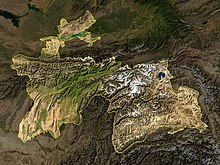
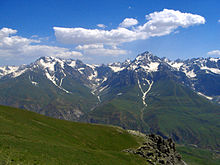



No comments:
Post a Comment